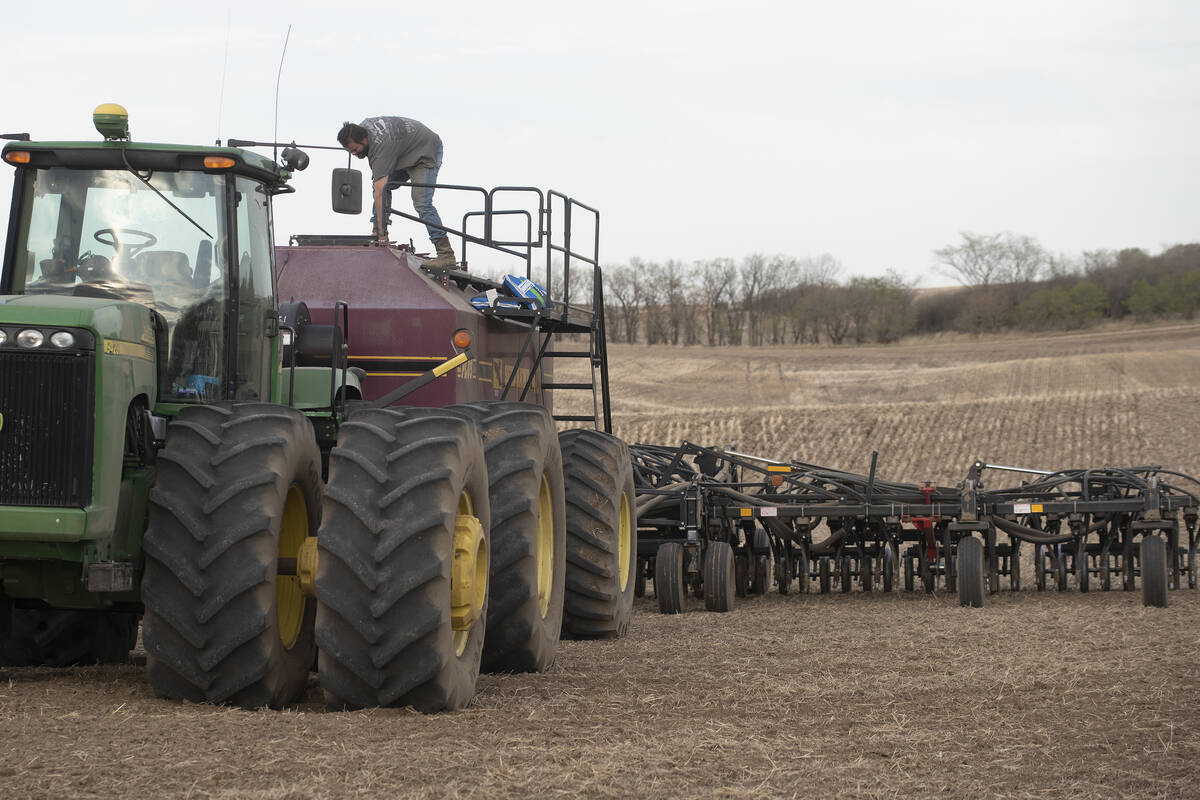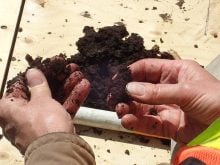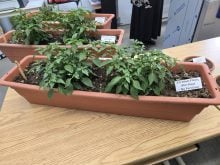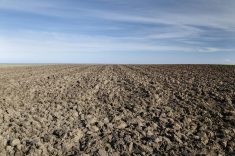Blain Hjertaas insists farmers already have the key to solving climate change. It’s growing in their fields.
Ground should never be bare, the holistic management instructor argued in Pipestone March 14, part of an event dissecting agriculture’s role in climate change.
Hjertaas argued that conventional annual cropping leaves gaps in early spring and in fall after harvest where nothing is growing and solar energy is being wasted. Instead, he said, longer green cover would maximize time plants are available to photosynthesize, taking carbon dioxide out of the air and converting it to carbon as they grow. That same carbon is later stored in the soil as roots and residue break down into organic matter.
Read Also

Nutrien pays farmers for efficient nitrogen
Nutrien’s Sustainable Nitrogen Outcomes (SNO) program pays Prairie farmers to limit nitrogen loss and, therefore, fertilizer-related greenhouse gas emissions.
That concept of carbon sequestration became a key point of the day.
Course correction?
Hjertaas’s ideas represent what is increasingly called “regenerative agriculture,” methods focused on building soil organic matter, jump-starting soil biology, lessening input use, and increasing diversity both above and below the ground.
“I think it’s a process we’re all learning that we know, kind of, where we’re going, but the type of agriculture that we have today didn’t develop quickly either. It took a long time and we’ve gained an awful lot of skills along the way,” Hjertaas said. “I think now it’s time to make a mid-course correction and we need to learn an awful lot of skills about moving in a more regenerative way. I think we understand the principles, but the practices, I don’t think we know them all. I think there’s a lot of learning to be done, but there’s tremendous innovation among farmers.”
Some of those methods have come to include things like cover crops, intercrops and mob grazing, with livestock intensely grazing a small area for a short period of time, followed by a long rest period for the land, something advocates argue encourages more forage production, deeper roots, and therefore more carbon sequestration and organic matter. By the same token, grazing cover crops has been offered as an option for farmers looking for some economic return on what would otherwise be a pure expense for the sake of soil health.
His operation near Redvers, Sask., has been managed under regenerative practices for the last two decades. In 2014, he estimated that he sequestered 239.61 tonnes of carbon per hectare on his mob grazed acres, a number that he suggests is on an upwards trend, jumping over six tonnes of carbon per hectare per year for every year his land is under regenerative management.

Michael Thiele of the Ducks Unlimited Grazing Club is another voice arguing for rotational grazing to bolster forage growth and, therefore, stored carbon.
Thiele helped spearhead a three-year project with Brandon-area farmer Brian Harper of Circle H Farms on high density mob grazing.
Those results have become central to Thiele’s efforts to sway producers towards planned grazing and regenerative agriculture.
Circle H Farms reported longer grazing seasons, excess forage and a 9,400-pound increase in beef taken off the same pasture within three years, along with a 0.7 per cent increase in organic matter, Solvita test jump from 26.6 to 71.7 and a dramatic jump in biodiversity, both in the soil and in terms of wildlife like birds.
“To me, this is the solution we’ve been waiting for, for 30 years, not only for agriculture but conservation — soil, water, wildlife. It’s just very few are kind of getting it yet,” Thiele said. “Luckily, producers are the ones who are getting it first. Conservation is kind of struggling, because how can the thing that caused the problem, agriculture, be the solution? It can. We just change agriculture.”
Still fringe
But while advocates like Thiele and Hjertaas cite gains, regenerative agriculture remains a small portion of the overall farm landscape.
Profit has seemingly not been the persuasive argument that Thiele hoped when results of the three-year study came in, with farmers reluctant to move away from established practices, he said.
Livestock have been critical to many regenerative agriculture success stories, although Hjertaas says that farmers can build soil health without them, albeit not as quickly. Large-scale agriculture, however, makes livestock integration a hard sell for increasingly specialized, increasingly large, farms.
Regenerative agriculture advocates often argue that beef and grain producers could team up to solve that issue. In practice, however, sharing livestock hits logistical hurdles if producers don’t share the same vision, can’t reach an agreement or fail to find another producer in the area willing to enter such a deal.
A co-operative cattle herd, bolstered by outside investors, might be the solution to that problem, Hjertaas suggested.
“So we have this huge pool of cattle that is then managed by a group of existing cattle producers that have the knowledge to run that,” he said. “That then has to be shared out to grain producers who have the desire; they want to improve soil health; they know that they need to sow something different down, cover crops something like that, and here is this pool of cattle that is available for this purpose.”
Revenue from cattle fed and sold through the program would then be shared between grain farmers, cattle operators and investors involved with the co-operative.
Likewise, Hjertaas does not expect anyone to bankrupt themselves for the sake of their soils. Benefits from the system will not happen overnight, he warned, and may, in fact, take years where the farmer still has to make a profit.
He also does not expect farmers to totally do away with inputs. High-input agriculture also leads to high greenhouse gas emissions, he said, but added that he has no issue with a farmer turning to fertilizer or herbicide to solve a problem. The concern, he said, comes when inputs become habitual without solving the underlying problem.
“They need to understand what soil health is and they need to understand that when soil gets healthy it becomes more profitable, but it’s not a quick fix, so they have to think about, on their own operation with their own management, what they can do to change that will achieve those goals, while at the same time not sinking the farm doing it and it’s little steps, I think,” he said.
Government funding
The province has insisted that there is money coming in for green projects, although it’s unclear if anything on the regenerative agriculture wish list will see that money.
Manitoba officially passed its $25-per-tonne carbon tax March 15, to take effect in September. The announcement was made soon after Manitoba joined the Pan-Canadian Framework on Clean Growth and Climate Change in late February.
The province is sticking to its guns on carbon price, a schedule that would keep Manitoba in line with federal policy for only 2-1/2 years as federal carbon tax policy ramps up to $50 a tonne by 2022, but provincial officials argued that joining the framework was necessary to access up to $67 million in federal funds to decrease greenhouse gas emissions.
At the same time, the province has promised $40 million for “projects in Manitoba dedicated to help reduce emissions and adapt to climate change,” a definition that extends to public transportation projects, natural restoration and energy efficiency in buildings.
For his part, Hjertaas is skeptical of both the provincial and national climate plans.
“They’re not doing anything to deal with actual climate change,” he said. “That’s the political talk, but it’s not solving the problem. The only way we can solve it is putting the carbon back into the ground and make the hydrological cycle cool the earth more effectively. That’s in our hands… if you want it to happen rapidly, what you do is you pay us to do that. That’s what will make it roll.”
The holistic management instructor would see farmers paid directly for the carbon they sequester; something he says is necessary to get new producers to buy in.
For his part, Thiele would like to see new grazing practices and farmer education get a nod from those government funds.
“We’re doing work to show how much carbon we can sequester just by using cows, good grazing management,” he said, pointing to the high density grazing experiment at Circle H Farms.
“With the 7-1/2 tonnes that Brian Harper is sequestering per acre per year, 7-1/2 tonnes times $25 a tonne, that’s a lot of money,” he said. “It’s regenerative ag. This is a revolution. We are going to change how agriculture gets done, how we think about agriculture.”
















